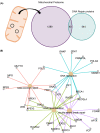Beyond base excision repair: an evolving picture of mitochondrial DNA repair
- PMID: 34608928
- PMCID: PMC8527207
- DOI: 10.1042/BSR20211320
Beyond base excision repair: an evolving picture of mitochondrial DNA repair
Abstract
Mitochondria are highly specialised organelles required for key cellular processes including ATP production through cellular respiration and controlling cell death via apoptosis. Unlike other organelles, mitochondria contain their own DNA genome which encodes both protein and RNA required for cellular respiration. Each cell may contain hundreds to thousands of copies of the mitochondrial genome, which is essential for normal cellular function - deviation of mitochondrial DNA (mtDNA) copy number is associated with cellular ageing and disease. Furthermore, mtDNA lesions can arise from both endogenous or exogenous sources and must either be tolerated or corrected to preserve mitochondrial function. Importantly, replication of damaged mtDNA can lead to stalling and introduction of mutations or genetic loss, mitochondria have adapted mechanisms to repair damaged DNA. These mechanisms rely on nuclear-encoded DNA repair proteins that are translocated into the mitochondria. Despite the presence of many known nuclear DNA repair proteins being found in the mitochondrial proteome, it remains to be established which DNA repair mechanisms are functional in mammalian mitochondria. Here, we summarise the existing and emerging research, alongside examining proteomic evidence, demonstrating that mtDNA damage can be repaired using Base Excision Repair (BER), Homologous Recombination (HR) and Microhomology-mediated End Joining (MMEJ). Critically, these repair mechanisms do not operate in isolation and evidence for interplay between pathways and repair associated with replication is discussed. Importantly, characterising non-canonical functions of key proteins and understanding the bespoke pathways used to tolerate, repair or bypass DNA damage will be fundamental in fully understanding the causes of mitochondrial genome mutations and mitochondrial dysfunction.
Keywords: DNA replication and recombination; DNA synthesis and repair; genome integrity; mtDNA.
© 2021 The Author(s).
Conflict of interest statement
The authors declare that there are no competing interests associated with the manuscript.
Figures


References
Publication types
MeSH terms
Substances
LinkOut - more resources
Full Text Sources

